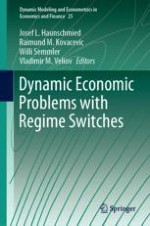2021 | OriginalPaper | Buchkapitel
12. Optimal Taxation with Endogenous Population Growth and the Risk of Environmental Disaster
verfasst von : Tapio Palokangas
Erschienen in: Dynamic Economic Problems with Regime Switches
Aktivieren Sie unsere intelligente Suche, um passende Fachinhalte oder Patente zu finden.
Wählen Sie Textabschnitte aus um mit Künstlicher Intelligenz passenden Patente zu finden. powered by
Markieren Sie Textabschnitte, um KI-gestützt weitere passende Inhalte zu finden. powered by
